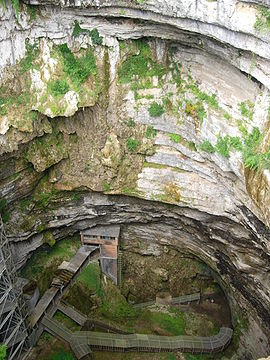
Padirac Cave
Encyclopedia

Cave
A cave or cavern is a natural underground space large enough for a human to enter. The term applies to natural cavities some part of which is in total darkness. The word cave also includes smaller spaces like rock shelters, sea caves, and grottos.Speleology is the science of exploration and study...
located near Gramat
Gramat
Gramat is a commune in the Lot department in south-western France....
, in the Lot département, in France
France
The French Republic , The French Republic , The French Republic , (commonly known as France , is a unitary semi-presidential republic in Western Europe with several overseas territories and islands located on other continents and in the Indian, Pacific, and Atlantic oceans. Metropolitan France...
.
Features
The chasm itself is approximately 99 m (324.8 ft) around its rim with a diameter of approximately 35 metres (114.8 ft). Visitors descend 75 m via a lift or a staircase before entering the cave system. The cave, at a depth of 103 metres (337.9 ft), contains a subterranean river system that is partly negotiable by boat. This cave system is regarded as "one of the most extraordinary natural phenomena of the Massif CentralMassif Central
The Massif Central is an elevated region in south-central France, consisting of mountains and plateaux....
".
Formation
The chasm was created at an undetermined point in time when the roof collapsed into a large internal cavern. It is known that the cavern existed in the 3rd century, and was inhabited during the 15th and 16th centuries during which time Potassium nitratePotassium nitrate
Potassium nitrate is a chemical compound with the formula KNO3. It is an ionic salt of potassium ions K+ and nitrate ions NO3−.It occurs as a mineral niter and is a natural solid source of nitrogen. Its common names include saltpetre , from medieval Latin sal petræ: "stone salt" or possibly "Salt...
was excavated from the area.
Tourism
The first tourists visited the cave on November 1, 1898, however the site was officially opened for tourism on April 10, 1899 by Georges LeyguesGeorges Leygues
Georges Leygues was a French politician of the Third Republic. During his time as Minister of Marine he worked with the navy's chief of staff Henri Salaun in unsuccessful attempts to gain naval re-armament priority for government funding over army rearmament such as the Maginot Line.He was born...
, the 87th prime minister of France (then called président du conseil). Today, although the cave system is made up of more than 40 km (24.9 mi) of galleries, only 2 km have been opened for tourism.
Since the 1930s, visitors can access the underground cave system by descending 75 m by lift or stairs, and then exploring the cave system on foot and by boat.
Padirac holds the record for the most frequently visited underground tourism facility in France. More than 350,000 visitors annually, and a record of 460,000 in 1991.
Exploration
The cave was first explored, in 1889, by Édouard-Alfred MartelÉdouard-Alfred Martel
, the 'father of modern speleology', was a world pioneer of cave exploration, study, and documentation...
. Much of the credit for opening the cave system is owed to Guy de Lavaur (1903–1986), who came to Padirac
Padirac
Padirac is a commune in the Lot department in south-western France....
in 1938 and managed to penetrate 15 km (9.3 mi) of the passages.

